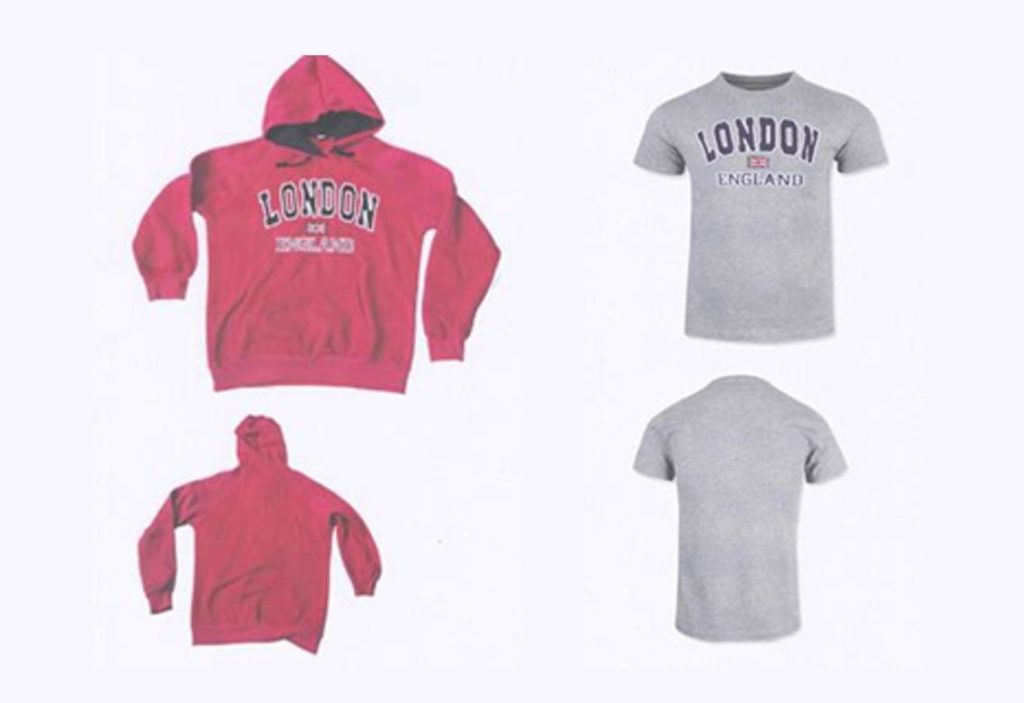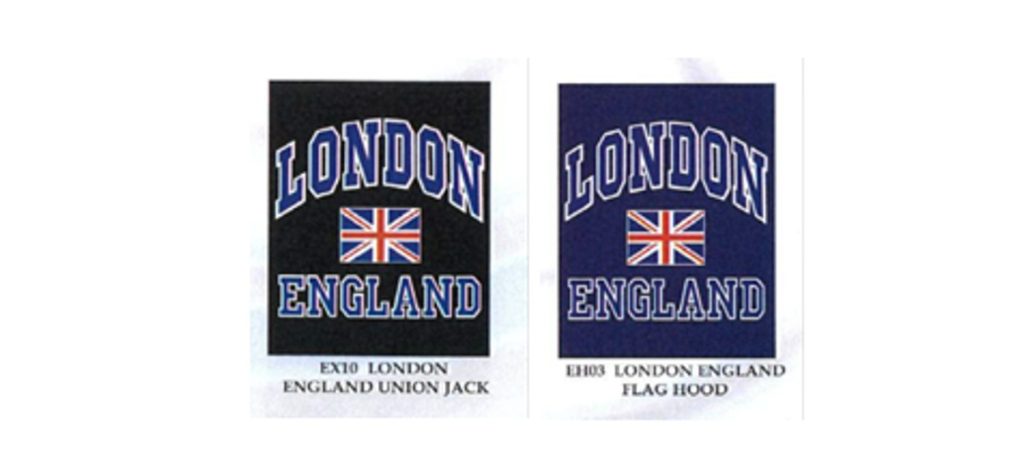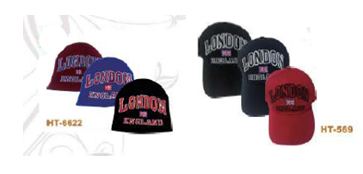June 27, 2022
Facts
Ahmet Erol owns two UK registered designs as follows:

the Hoody Design and the T-shirt Design.
Both Designs were registered on 18 May 2011. Mr Erol issued proceedings against Posh Fashion Ltd for infringement of his Designs.
The main issue at trial was whether Mr Erol’s Designs were: (i) new; and (ii) had individual character on 18 May 2011.
Posh Fashion relied on three alleged items of prior art:
(i) A brochure from 1999 produced by Urban Attitude featuring two designs, one under a section headed “Expantex Teeshirts” and the second under a section headed “Printed Hooded Tops”:

The brochure also included order forms for “printed teeshirts” in the colour grey;
(ii) a poor-quality image of a red hoody said to bear the same “London + Flag + England” logo and said to have been on the website of a London tourist outlet, Lambert Souvenirs, in March 2008:

and
(iii) two images of hats and caps from a brochure produced by KK Hosiery, run by Mr Zarguly of Posh Fashion, dating from 2007 to 2008:

Decision
The Hoody Design
Recorder Douglas Campbell QC found that the only element that could convey novelty and/or original character on the Hoody Design was the logo itself. The nature of the fabric (e.g., 100% cotton) was not indicated, nor was any mention made that the logo was embroidered rather than printed. Therefore, neither of these characteristics formed part of the Hoody Design.
Given that the Hoody Design was in colour, the colours (principally red) formed part of the design (PMS v Magmatic [2026] UKSC 12). However, Recorder Campbell also found that the colours used were common, standard, frequently used colours having no individual character either alone or in combination.
Urban Attitude
In Recorder Campbell’s view:
- the Urban Attitude “London+Flag+England” logo was identical to that in the Hoody Design;
- nothing turned on the fact that there was no image in the brochure showing a hoody with the “London+Flag+England” logo, as the hoody shown in the Hoody Design was unexceptional and the brochure expressly indicated that a hoody would be supplied with the “London+Flag+England” logo applied;
- it made no difference that a hoody from the catalogue might not be the same colour as the Hoody Design, since the colours were all unexceptional; changing from, e.g., blue to red, did not confer individual character; and
- even assuming the Hoody Design was novel over the Urban Attitude brochure, it still lacked individual character in relation to it since the overall impression was the same in both cases.
Therefore, the main question was whether the Urban Attitude catalogue genuinely dated from 1999.
Recorder Campbell rejected Mr Erol’s claim that the 1999 date had been fraudulently added to the brochure and that the designs were in fact from much later, accepting Posh Fashion’s evidence as to how it had obtained the brochure. Further, Mr Erol had not asked to see the original brochure, which had been copied by Posh Fashion’s solicitors for the purpose of the trial, and he provided no evidence to suggest that Posh Fashion’s director had been guilty of any wrongdoing.
Accordingly, Recorder Campbell found that the brochure genuinely dated from 1999 and that the Hoody Design was invalid in respect of it.
Lambert Souvenirs
Although it was not necessary to consider this alleged prior art, Recorder Campbell did so in the event that his decision on the Urban Attitude catalogue was wrong.
Mr Erol accepted that the Lambert Souvenirs image was in fact of his product, which he had produced as samples in very limited quantities in 2008.
Recorder Campbell rejected Mr Erol’s suggestion that the Lambert Souvenirs image had been inserted into its website “afterwards through editing”, as the image had been obtained via the Wayback Machine and (barring a highly sophisticated web-based fraud, which was not established) any editing would have had to have been done in 2008. There was no reason for anyone to have done this, particularly since Mr Erol had accepted that the image shown was of his product from 2008.
Recorder Campbell also rejected Mr Erol’s claim that the differences between the Lambert Souvenirs product image and the Hoody Design meant that the Hoody Design had individual character. Two of the differences claimed were irrelevant as they were not apparent from the registration and the others were not significant, meaning that the overall impression of the Lambert Souvenirs product and the registration was still the same. Accordingly, Recorder Campbell found that the Hoody Design was invalid in relation to this prior art as well.
KK Hosiery
The issue here was that although the “London+Flag+England” logo was the same as in the Hoody Design, the garments were different. Recorder Campbell had found that the hoody in the Hoody Design was unexceptional, but since this validity attack was clearly weaker than the other two, he decided not to make any findings.
The T-shirt Design
Recorder Campbell said that much of the same reasoning applied here as it did in relation to the Hoody Design. He found that the design of the T-shirt itself was unexceptional, and again concluded that the colour was part of registration. Once again, the colours (principally grey) were commonly used.
Urban Attitude
As in relation to the Hoody Design, and for substantially similar reasons, Recorder Campbell found that the Urban Attitude brochure invalidated the T-shirt Design. There was a slightly stronger case for anticipation (i.e., lack of novelty) because the Urban Attitude brochure specifically mentioned the colour grey in relation to T-shirts, but even assuming there was no anticipation, the T-shirt Design still lacked individual character in respect of the relevant part of the Urban Attitude brochure because the overall impression was the same.
KK Hosiery
The same issue arose here as it did in relation to the Hoody Design and, again, Recorder Campbell said it was unnecessary to make any findings.
Squeeze argument
Posh Fashion also ran a squeeze argument that its garments produced on the informed user an overall impression different to both the Designs as it had not sold any grey t-shirts or red hoodies.
Recorder Campbell said that there was force in this argument but given that he had held both Designs to be invalid the issue did not arise. (Ahmet Erol v Posh Fashion Ltd [2022] EWHC 195 (IPEC) (8 February 2022) — to read the judgment in full, click here).
Expertise